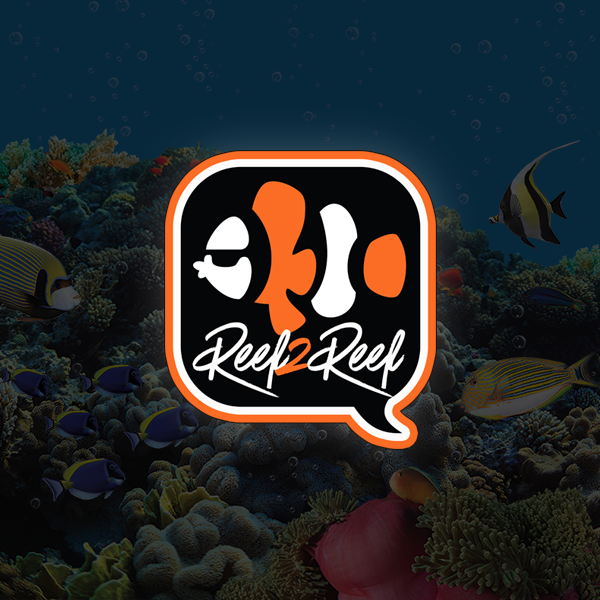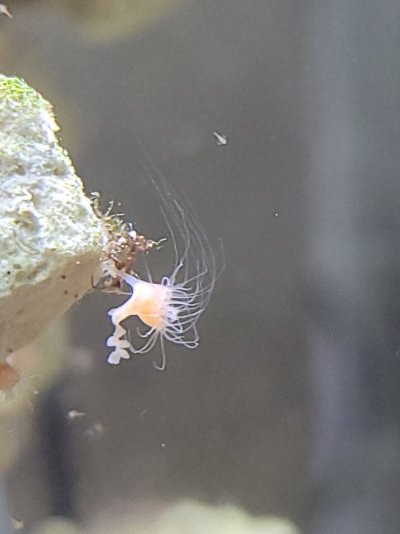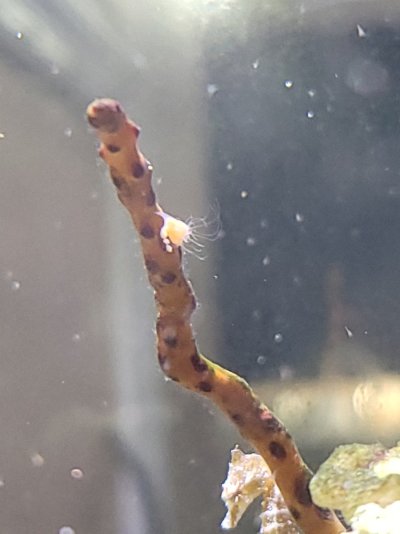Navigation
Install the app
How to install the app on iOS
Follow along with the video below to see how to install our site as a web app on your home screen.

Note: This feature currently requires accessing the site using the built-in Safari browser.
More options
You are using an out of date browser. It may not display this or other websites correctly.
You should upgrade or use an alternative browser.
You should upgrade or use an alternative browser.
Odd pink growths?
- Thread starter bcaruso67
- Start date
This one is tricking me. It looks like a nem of some type (mojano or ball (which is actually a mushroom)), but the longer tentacles are throwing me off. That got me thinking aiptaisa....
ISpeakForTheSeas
2500 Club Member
- Review score
- +0 /0 /-0
R2R Supporter
R2R Excellence Award
- Joined
- Nov 22, 2021
- Messages
- 3,058
- Reaction score
- 3,640
- Review score
- +0 /0 /-0
- Location
- United States
Those seem to be polyp stage jellyfish (we normally think of jellyfish in their free-swimming medusa stage) that are reproducing.
As far as getting rid of them goes, if you have hundreds of these, it may be easier to just move the dwarf seahorses to a temporary tank and starve the jellies out. Otherwise, you can probably deal with them the same way you would deal with hydroids (see the thread linked below, starting with my post for advice on hydroid removal - there should be three or four posts in total with advice).

 www.reef2reef.com
www.reef2reef.com
Welcome to Reef2Reef!
As far as getting rid of them goes, if you have hundreds of these, it may be easier to just move the dwarf seahorses to a temporary tank and starve the jellies out. Otherwise, you can probably deal with them the same way you would deal with hydroids (see the thread linked below, starting with my post for advice on hydroid removal - there should be three or four posts in total with advice).

Need Help!!! Never seen this before
Getting a bit irrational are we? You people are sensitive. how about we don't start a fight, please? all of us are trying to help someone.
 www.reef2reef.com
www.reef2reef.com
Welcome to Reef2Reef!
Yes, it's been crazy trying to figure out.This one is tricking me. It looks like a nem of some type (mojano or ball (which is actually a mushroom)), but the longer tentacles are throwing me off. That got me thinking aiptaisa....
Thanks, so these have been in here for now a month and started as 1 or 2 then like in less than a week hundreds.Those seem to be polyp stage jellyfish (we normally think of jellyfish in their free-swimming medusa stage) that are reproducing.
As far as getting rid of them goes, if you have hundreds of these, it may be easier to just move the dwarf seahorses to a temporary tank and starve the jellies out. Otherwise, you can probably deal with them the same way you would deal with hydroids (see the thread linked below, starting with my post for advice on hydroid removal - there should be three or four posts in total with advice).

Need Help!!! Never seen this before
Getting a bit irrational are we? You people are sensitive. how about we don't start a fight, please? all of us are trying to help someone.www.reef2reef.com
Welcome to Reef2Reef!
ISpeakForTheSeas
2500 Club Member
- Review score
- +0 /0 /-0
R2R Supporter
R2R Excellence Award
- Joined
- Nov 22, 2021
- Messages
- 3,058
- Reaction score
- 3,640
- Review score
- +0 /0 /-0
- Location
- United States
Yeah, they're likely feeding on whatever you're feeding your seahorses. The little tails you see sticking off the specimens in your photos are part of how they reproduce. I can't find a photo exactly like the one shown in your pics, but here are a few different methods:Thanks, so these have been in here for now a month and started as 1 or 2 then like in less than a week hundreds.
Photo source:
Loading…
www.researchgate.net
Again thank you! That has been a big help. I've been looking for a week now for images that looked the same w no luck. What are your thoughts on clean up crew for these? Like emrald crabbs or even adding a file fish?Yeah, they're likely feeding on whatever you're feeding your seahorses. The little tails you see sticking off the specimens in your photos are part of how they reproduce. I can't find a photo exactly like the one shown in your pics, but here are a few different methods:
View attachment 3136418
Photo source:
Loading…
www.researchgate.net
ISpeakForTheSeas
2500 Club Member
- Review score
- +0 /0 /-0
R2R Supporter
R2R Excellence Award
- Joined
- Nov 22, 2021
- Messages
- 3,058
- Reaction score
- 3,640
- Review score
- +0 /0 /-0
- Location
- United States
I only know of a handful of things that will eat jellyfish polyps that are readily available in the hobby and that (theoretically) shouldn't immediately be super dangerous to your seahorses which could fit in your tank:What are your thoughts on clean up crew for these? Like emrald crabbs or even adding a file fish?
- Camel Shrimp (Rhynchocinetes uritai)
- Long-clawed Hermit (Pagurus longicarpus)
- Skeleton Shrimp (Caprella equilibra isn't available specifically, but other Caprella sp./spp. are available and may eat the polyps as well, I'm not sure)
Emerald crabs, filefish, etc. may or may not prey on the polyps (and it may depend on what species of jellyfish it is).
Camel Shrimp can be found on a bunch of different sites. The Long-clawed Hermit and Skeleton Shrimp are harder to come by, but both are available through the site linked below (it's a coldwater site, so if you order from them, you may want to be extra careful about temperature acclimation; that said, both species can handle a wide range of temps, so, once acclimated, they'll likely do fine at whatever temp your tank is at):
Skeleton Shrimp (Caprella spp.) | Gulf Of Maine, Inc.
Common name: skeleton shrimp Scientific name: Caprella spp. Locations: muddy, sub-tidal substrate, shallow and deep water Seasonality: collected here December-April Color: translucent-white Size: ½” - 2” Collected: dip
Long-clawed Hermit Crab (Pagurus longicarpus) | Gulf Of Maine, Inc.
Common name: long-clawed hermit crab Scientific name: Pagurus longicarpus Locations: intertidal zones on muddy or pebbly bottoms, found in tide pools Seasonality: available all year Color: beige, light brown, green, brown Size: 1/2

Isopods and Amphipods - Gulf Specimen Marine Lab
The primitive, minute crustaceans can be found everywhere, as commensals and as parasites on oysters, in sponges, and hydroid masses, crawling like little bugs over algae clumps, in oceanic, brackish and fresh water. Everything eats them. Watch Isopod and Amphipods videos on youtube.com Giant...
gulfspecimen.org
Thank you for all of this great information. I appreciate your time and advice and will look into these possible solutions.I only know of a handful of things that will eat jellyfish polyps that are readily available in the hobby and that (theoretically) shouldn't immediately be super dangerous to your seahorses which could fit in your tank:
- Camel Shrimp (Rhynchocinetes uritai)
- Long-clawed Hermit (Pagurus longicarpus)
- Skeleton Shrimp (Caprella equilibra isn't available specifically, but other Caprella sp./spp. are available and may eat the polyps as well, I'm not sure)
Emerald crabs, filefish, etc. may or may not prey on the polyps (and it may depend on what species of jellyfish it is).
Camel Shrimp can be found on a bunch of different sites. The Long-clawed Hermit and Skeleton Shrimp are harder to come by, but both are available through the site linked below (it's a coldwater site, so if you order from them, you may want to be extra careful about temperature acclimation; that said, both species can handle a wide range of temps, so, once acclimated, they'll likely do fine at whatever temp your tank is at):

Skeleton Shrimp (Caprella spp.) | Gulf Of Maine, Inc.
Common name: skeleton shrimp Scientific name: Caprella spp. Locations: muddy, sub-tidal substrate, shallow and deep water Seasonality: collected here December-April Color: translucent-white Size: ½” - 2” Collected: dipgulfofme.com
You can also find the skeleton shrimp Caprella acutifrons at the link below:
Long-clawed Hermit Crab (Pagurus longicarpus) | Gulf Of Maine, Inc.
Common name: long-clawed hermit crab Scientific name: Pagurus longicarpus Locations: intertidal zones on muddy or pebbly bottoms, found in tide pools Seasonality: available all year Color: beige, light brown, green, brown Size: 1/2gulfofme.com

Isopods and Amphipods - Gulf Specimen Marine Lab
The primitive, minute crustaceans can be found everywhere, as commensals and as parasites on oysters, in sponges, and hydroid masses, crawling like little bugs over algae clumps, in oceanic, brackish and fresh water. Everything eats them. Watch Isopod and Amphipods videos on youtube.com Giant...gulfspecimen.org
Similar threads
- Replies
- 7
- Views
- 204
- Replies
- 0
- Views
- 41

















